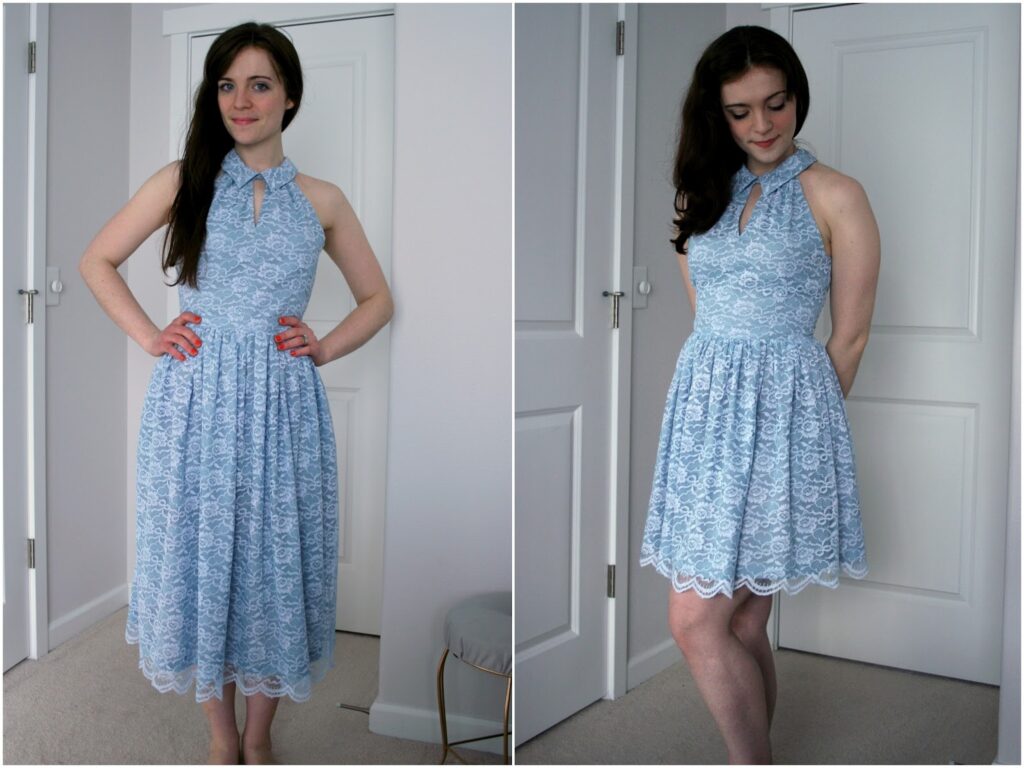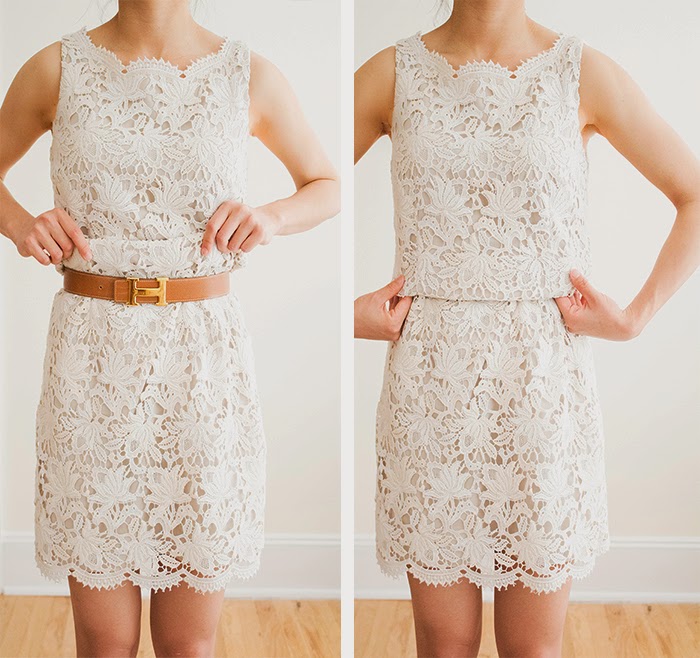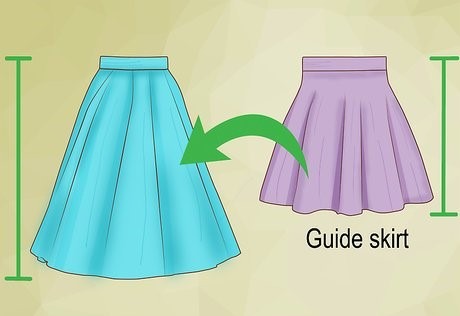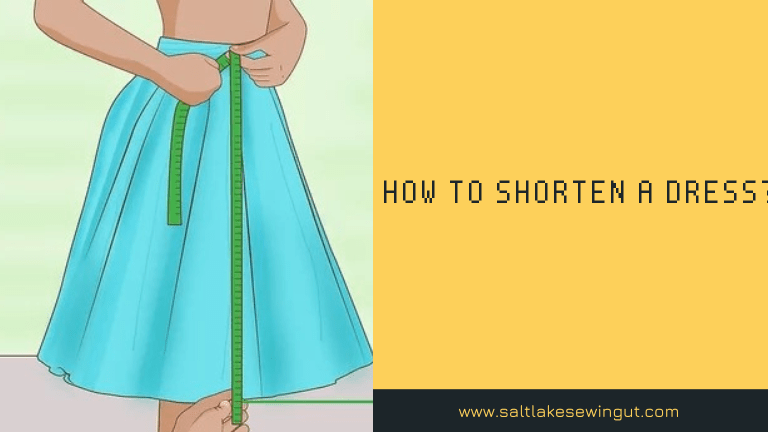what happens when you stumble upon a stunning dress that fits perfectly everywhere except the length and Shorten a dress? Don’t worry; you don’t need to leave that dress behind. In this comprehensive guide, we’ll walk you through the process of shortening a dress to make it the perfect fit for your body. Whether you’re a seasoned DIY enthusiast or a novice, we’ve got you covered with easy-to-follow steps and expert tips.
Hand Hemming for Shorten a dress
Hemming a dress by hand can be a satisfying and precise way to achieve the perfect length. With just a few essential tools like fabric scissors, a needle, thread, and pins, you can make your dress fit flawlessly. Easy Methods to Shorten a Dress:
Measure Carefully: Begin by measuring the length from the waist down to your desired dress length. Mark this point with pins or chalk.
Trim with Caution: Using fabric scissors, trim the dress fabric, following the marked line. It’s essential to be cautious here, ensuring you don’t cut off too much fabric.
Secure the Hem: Fold the fabric up to create a double-folded hem. Iron it to create a neat crease.
Thread the Needle: Thread your needle with a thread that matches the dress color. Tie a knot securely at the end of the thread.
Begin Hemming: Starting at one end of the hem, insert the needle from the inside of the folded hem to hide the knot.
Stitch in Place: Take small, evenly spaced stitches, about 1/8 inch apart, securing the folded hem in place.
Repeat Across the Hem: Continue stitching along the entire hemline, ensuring your stitches are consistent and secure.
Knot the End: When you reach the end of the hemline, make a small knot by passing the needle through a loop in the thread. Trim any excess thread.
Press for Perfection: Turn the dress right side out and press the hem with an iron to create a crisp, professional finish.
Final Fit Check: Try on the dress to make sure the hem is even and falls at your desired length. Make any necessary adjustments if needed.
Hem with a Sewing Machine
Using a sewing machine offers a simpler method for altering the length of a dress. Begin by measuring the dress’s length from the waist to your desired hemline, and trim away any surplus fabric. Be sure to employ a stabilizing line and pins during the hemming process to prevent fabric movement while sewing. After completing the alteration, double-check the stitching to ensure it’s securely done before donning your dress.
Cutting with Fabric Shears to Shorten a dress
Another uncomplicated method to shorten a dress involves using fabric shears. Commence by gauging the dress’s length from the waist to your preferred hemline, then employ fabric shears to remove any surplus fabric. While cutting, ensure that your shears remain parallel to the dress’s hem, and exercise caution not to trim excessively.

Turning Up a Hem
To turn up a hem:
Measure and mark the desired length.
Fold the fabric to that mark.
Pin it in place.
Iron for a crisp edge.
Sew along the fold.
Secure the end with a knot or backstitch.
Trim excess thread.
Press the hem again for a neat finish.
Inspect for evenness and adjust if needed.
Adding a Pleated Hem To shorten a dress
Measure and mark the desired length.
Fold the fabric up to the mark.
Create evenly spaced pleats along the fold.
Pin the pleats in place.
Iron to set the pleats.
Sew across the top of the pleats to secure them.
Trim excess fabric if necessary.
Press the pleated hem for a polished look.
Adding a Lace Trim to shorten a dress
Measure the desired length of the lace trim.
Pin the lace along the hem’s edge, right sides together.
Sew the lace to the hem using a straight stitch.
Trim any excess lace.
Fold the lace and fabric hem together.
Sew close to the fold to secure the lace.
Press for a neat finish.
Inspect for evenness and adjust if needed.
Adding an Elastic Waistband To Shorten a Dress
Measure the elastic to your waist size.
Overlap the ends and sew them together to form a loop.
Pin the loop evenly around the waist of the garment.
Sew the elastic to the waist, stretching it as you sew.
Trim any excess elastic.
Fold the waistband fabric over the elastic and sew it down.
Ensure the elastic is evenly distributed.
Press for a smooth finish.
Adjust the gathers as needed for comfort.

Determining the Right Length For You:
To determine the right length for you:
Measure: Use a measuring tape to measure from the point on your body where the garment will sit (e.g., waist, hips) to the desired length.
Consider the Style: Keep in mind the style of the garment. Some styles may look better longer or shorter.
Think About Shoes: Consider the shoes you plan to wear with the garment. Different shoes may affect the ideal length.
Check Proportions: Take your body proportions into account. A length that flatters your height and body shape is key.
Try It On If possible, try the garment on and assess how it looks and feels at different lengths.
Ask for Opinions: Get input from friends or family to see what they think looks best on you.
Experiment: Don’t be afraid to experiment with different lengths until you find what you feel most comfortable and confident in.
Customize: Tailoring or hemming can help you achieve the perfect length for your specific body and preferences.

What You’ll Need:
Here’s what you’ll need for various sewing projects:
Fabric: Choose the fabric that suits your project. Consider weight, stretch, and color.
Sewing Machine: For efficiency, accuracy, and speed, a sewing machine is a valuable tool.
Needles: Different needles are used for various fabrics. Universal and ballpoint needles are versatile.
Thread: Use thread that matches your fabric or desired look. Polyester thread is a good all-purpose choice.
Scissors: Invest in sharp fabric scissors for cutting fabric and paper scissors for patterns.
Pins and Pincushion: Pins hold fabric pieces together, and a pincushion keeps them organized.
Measuring Tools: A measuring tape, ruler, and pattern weights help with precision.
Seam Ripper: To correct mistakes and remove unwanted stitches.
Iron and Ironing Board: Essential for pressing seams and achieving a polished finish.
Pattern: If not sewing freehand, you’ll need a pattern for your project.
Interfacing: Provides structure to fabric, often used for collars and cuffs.
Elastic: For waistbands or cuffs in garments.
Buttons, Zippers, or Fasteners: Depending on your project’s closures.
Bias Tape or Trims: Decorative or functional elements for edges and seams.
Marking Tools: Fabric chalk or washable markers to mark the fabric.
Thimble: Protects your finger when hand sewing.
Sewing Box or Organizer: Keeps your supplies neat and accessible.
Pattern Paper: For tracing or drafting your own patterns.
Safety Pins: Useful for various tasks, including threading elastic.
Serger (optional): For finishing edges and creating professional seams.
The specific items you need will depend on your sewing project, so always check your pattern or project instructions for any additional requirements.
Steps to Shorten a Dress
To shorten a dress, follow these steps:
Gather Your Supplies:
Shorten a dress
Measuring tape
Pins
Scissors
Iron and ironing board
Sewing machine or needle and thread
Chalk or fabric marker
Seam ripper (if necessary)
Try On the Dress:
Put on the dress and determine the desired length. Use a mirror or have someone help you to ensure it’s even all around.
Mark the New Hemline:
Measure the desired length from the current hem and mark it with chalk or a fabric marker. Make sure it’s even all the way around.
Prepare the Dress:
Take off the dress and turn it inside out.
Remove the Old Hem (if necessary):
If the dress has an existing hem, you may need to remove it using a seam ripper to reveal the original hemline. Be careful not to damage the fabric.
Cut the Excess Fabric:
Carefully cut along the marked line, leaving a seam allowance (typically 1-2 inches) for the new hem. Ensure your scissors are parallel to the hem for a straight cut.
Fold and Pin the Hem:
Fold the fabric up along the marked line to create the new hem. Pin it in place with straight pins. Make sure the fold is even all around the dress.
Press the Hem:
Use an iron and ironing board to press the folded hem. This will create a crisp edge and make sewing easier.
Choose your Stitch:
If using a sewing machine, select an appropriate stitch for your fabric. For most fabrics, a straight stitch or a zigzag stitch will work. If sewing by hand, use a needle and thread that matches the fabric.
Sew the Hem:
Starting at a side seam, sew along the folded edge of the hem. Remove the pins as you go. If using a machine, guide the fabric evenly. If sewing by hand, make small, even stitches.
Backstitch or Knot:
When you reach the other side seam, backstitch (if using a machine) or tie a secure knot (if sewing by hand) to prevent the stitching from unraveling.
Trim Excess Thread:
Trim any excess thread with scissors.
Press Again:
After sewing, press the hem one more time to set the stitches and create a neat finish.
Inspect and Adjust:
Carefully inspect the hem to ensure it’s even and secure. Make any necessary adjustments.
Try On the Dress Again:
Put the dress back on to confirm that the length is perfect for you. Adjust if needed.
Finish Up:
Trim any remaining loose threads, and your shortened dress is ready to wear!

Hemming & Pressing: The Finishing Touch
Hemming and pressing are the finishing touches that give your sewing projects a polished and professional appearance. Here’s how to do it:
Hemming:
Turn Up the Hem: Begin by folding the raw edge of the fabric up to the marked hemline on the wrong side of the fabric. The amount you fold depends on your project and personal preference but is typically 1-2 inches.
Pin in Place: Use straight pins to secure the folded hem in place. Space the pins evenly to maintain an even hem.
Press: Heat up your iron to the appropriate temperature for your fabric (refer to the fabric care label). Press the folded hem with the iron to create a crisp edge. This step helps the hem stay in place while sewing.
Sewing: Depending on your project and sewing method, either machine sew or hand-sew the hem in place. For machine sewing, use an appropriate stitch for your fabric, typically a straight stitch or a zigzag stitch. Sew close to the folded edge, removing pins as you go. For hand sewing, use small, even stitches to secure the hem.
Backstitch or Knot: When you reach the end of the hem, backstitch (if using a machine) or tie a secure knot (if sewing by hand) to prevent the stitching from unraveling.
Pressing:
Set the Stitches: After hemming, press the hem once more with the iron, this time on the right side of the fabric. This helps set the stitches and gives the hem a professional appearance.
Steam (if needed): For some fabrics, a burst of steam from the iron can help set the stitches and create a smooth, flat hem.
Inspect: Carefully inspect the hem to ensure it’s even and secure. Make any necessary adjustments.
Tips To Shorten a Dress
Tips for shortening a dress:
Measure Twice: Double-check your desired length before cutting to avoid mistakes.
Use the Right Tools: Sharp fabric scissors and the appropriate sewing machine settings are crucial for a clean finish.
Press Carefully: Properly press the folded hem before and after sewing for a professional look.
Start Small: Cut less fabric initially; you can always trim more if needed.
Sew Slowly: When using a machine, sew slowly and steadily, especially around curves or delicate fabrics.
Match Thread Color: Choose a thread that matches the dress color for a seamless finish.
Test on Scrap: If you’re unsure about your sewing machine settings or stitching, test on a scrap fabric first.
Measure Evenly: Ensure the hem is the same length all around, using pins to maintain consistency.
Consider Fabric Type: Different fabrics require different techniques, so adjust your approach accordingly.
Fit Matters: Try the dress on after each adjustment to ensure the length suits your body and style preferences.
What to Do If You Make a Mistake Shorten a dress
If you make a mistake while shortening your dress, don’t panic. Mistakes happen, and many of them can be fixed. Here’s what to do:
Assess the Mistake: First, assess the nature and extent of the mistake. Determine if it’s something that can be corrected or if you need to start over.
Unpick the Stitches: If you made a sewing error, such as uneven stitching or stitching too close to the edge, carefully use a seam ripper to remove the stitches in that area. Be cautious not to damage the fabric.
Trim Carefully: If you cut the fabric too short, there might still be room to fix it. Consider sewing on a coordinating fabric or lace trim to add length or style.
Add a Ruffle or Band: Another option for fixing a too-short dress is to add a decorative ruffle or contrasting fabric band to the hem. This can not only correct the length but also add a unique touch to your dress.
Reattach Fabric: If you accidentally cut off too much fabric, see if you can salvage any scraps from the original hem. You may be able to reattach it to the dress.
Adjust the Style: Get creative with your dress design. If the mistake is significant and can’t be easily fixed, consider turning the dress into a different style, such as a top or skirt.
Seek Professional Help: If you’re unsure how to fix the mistake or if it’s a complex issue, consider taking the dress to a professional tailor or seamstress. They have the expertise to handle more challenging alterations.
Learn from Your Mistake: Use this experience as an opportunity to improve your sewing skills. Analyze what went wrong and how you can avoid similar mistakes in the future.
Uneven Hemlines: Ensure your dress has an even hemline by measuring and cutting carefully.
Cutting Too Short: Always leave a little extra length to avoid irreversible mistakes.
Neglecting Fabric Type: Different fabrics require different hemming techniques; be mindful of the fabric you’re working with.
How long does it take to shorten a dress?
shorten a dress typically takes a few hours, depending on your sewing skills and the complexity of the dress.
Can I shorten a dress with a lining?
Yes, you can shorten a dress with a lining, but it may require additional steps and attention to detail.
What is the average cost of a professional to shorten a dress?
The cost of a professional dress to shorten a dress varies but usually ranges from $20 to $50, depending on the dress’s complexity.
Can I use fabric glue for hemming?
While fabric glue can be used for hemming, it’s not as durable as sewing and may not provide a long-lasting finish.
Is it possible to lengthen a dress?
Lengthening a dress is more challenging than shortening a dress and it may require additional fabric to achieve the desired length.

